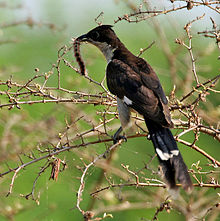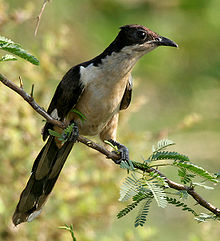- Jacobin Cuckoo
-
Jacobin Cuckoo 
Feeding on a hairy caterpillar Conservation status Scientific classification Kingdom: Animalia Phylum: Chordata Class: Aves Order: Cuculiformes Family: Cuculidae Genus: Clamator Species: C. jacobinus Binomial name Clamator jacobinus
Boddaert, 1783
dark green - year round
yellow - summer only
blue - winter
cream - passage onlySynonyms Oxylophus jacobinus
Coccystes melanoleucos
Coccystes hypopinariusThe Jacobin Cuckoo, Pied Cuckoo, or Pied Crested Cuckoo (Clamator jacobinus) is a member of the cuckoo order of birds that is found in Africa and Asia. It is partially migratory and in India, it has been considered a harbinger of the Monsoon rains due to the timing of its arrival.[2] It has been associated with a bird in Indian mythology and poetry, known as the Chatak and represented as a bird with a beak on its head that waits for rains to quench its thirst.
Contents
Description
This medium sized, slim black and white cuckoo with a crest is distinctive. The white wing patch on the black wing and the pattern make it unmistakable even in flight. They are very vocal during the breeding season. The call is a ringing series of whistling notes "skleer-skleer-eer, skleeur,skleeur" with the calls of the nominate form more rapid and slightly mellower.[3][4][5]
In India the subspecies serratus (Sparrman, 1786) is a summer breeding visitor to northern India and is believed to migrate to southern Africa. This is larger and longer winged than the nominate subspecies found in the southern peninsular region and Sri Lanka is said to be a local migrant.[6] No ringing evidence exists to support the actual migration to Africa.[7]
In Africa, subspecies serratus and pica (Hemprich & Ehrenberg, 1833) show two phases, a pied phase with white or whitish below and a black phase where the only white is on the wing patch. Mating appears to be assortative, with pied phase males pairing with pied phase females. An all-rufous color phase has been noted in Central Africa.[4] There is lack of clarity on the migration and plumage variation involved. Subspecies pica has been said to be the form that migrates between Africa and India[4] however Rasmussen & Anderton (2005) suggest serratus as being the valid name for the Afro-Indian migrants.[3][8][9][10]
In the past some other African subspecies have been suggested such as hypopinarus from South Africa and caroli from the Gabon.[11]
Distribution and habitat
The species is distributed south of the Sahara in Africa and south of the Himalayas in India. Also found in Sri Lanka and parts of Myanmar. Within Africa, there are movements of the species although they are resident in tropical Africa. The east African population is migratory and moves over southern Arabia into India during April.[4] The habitat of the species is mainly in thorny, dry scrub or open woodland[3] avoiding areas of dense forest or extremely dry environments.[4]
Behaviour and ecology
In the breeding season, birds call from prominent perches and chase each other with slow wing-beats and pigeon like clapping flight. Courtship feeding has been observed in Africa.[4] The species is a brood parasite and in India the host is mainly species of babblers in the genus Turdoides. The colour of the eggs matches those of the host, typically turquoise blue. The eggs are slightly larger than those of the Common Babbler T. caudatus or the Jungle Babbler T. striata. Other hosts include the Red-vented Bulbul, and the eggs laid are then mostly white.[12] Eggs are laid hurriedly in the morning into the nest of the host often dropped from while the bird perches on the rim of the nest and over the host eggs often resulting in the cracking of one or more host eggs.[6] In Africa, the males distract the host while the female lays the egg.[4] Multiple eggs may be laid in the nest of a host and two young cuckoos were found to fledge successfully in several occasions.[6] In Africa, the hosts include Pycnonotus barbatus, P. capensis,[13] Turdoides fulvus, Turdoides rubiginosus,[14] Lanius collaris, Andropadus importunus, Terpsiphone viridis, Dicrurus adsimilis[15] and a few other species.[4][7]
The skin of young birds darkens form pink to purplish brown within two days of hatching. The mouth linking is red with yellow gape flanges. Unlike some cuckoos, nestlings do not evict the eggs of the host from the nest although they claim most of the parental attention and food resulting sometimes, in the starvation of host nestlings.[4]
These cuckoos feed on insects including hairy caterpillars that are picked up from near or on the ground. Caterpillars are pressed from end to end to remove the guts before they are swallowed. They sometimes feed on fruits.[6]
In culture
This species is widely mentioned in ancient Indian poetry as the chātak.[16][17] According to Indian mythology it has a beak atop its head and it thirsts for the rains.[18] The poet Kalidasa used it in his "Meghadoota" as a metaphor for deep yearning and this tradition continues in literary works in Hindi.[19] Satya Churn Law, however noted that in Bengal, the bird associated with the "chatak" of Sanskrit was the Common Iora unlike the Jacobin Cuckoo suggested by European orientalists. He further noted that a captive Iora that he kept drank water only from dew and spray picked up from plant leaves suggesting that it may have been the basis for the idea that the "chatak" only drank raindrops.[20]
References
- ^ BirdLife International (2008). Clamator jacobinus. In: IUCN 2008. IUCN Red List of Threatened Species. Downloaded on 23 June 2009.
- ^ Khachar,Shivrajkumar (1989). "Pied Crested Cuckoo Clamator jacobinus - the harbinger of the monsoon.". J. Bombay Nat. Hist. Soc. 86 (3): 448–449.
- ^ a b c Rasmussen, PC & JC Anderton (2005). Birds of South Asia: The Ripley Guide.. 2. Smithsonian Institution & Lynx Edicions.. p. 225.
- ^ a b c d e f g h i Payne,RB (2005). The Cuckoos.. Oxford University Press. pp. 49, 320–325.
- ^ Baker, ECS (1927). Fauna of British India. Birds. Volume 4. Edition 2. Taylor and Francis, London. pp. 167–170. http://www.archive.org/stream/BakerFbiBirds4/BakerFBI4#page/n195/mode/1up.
- ^ a b c d Gaston, AJ (1976). "Brood Parasitism by the Pied Crested Cuckoo Clamator jacobinus.". Journal of Animal Ecology 45 (2): 331–348. doi:10.2307/3878.
- ^ a b Ali, S & S Dillon Ripley (1981). Handbook of the birds of India and Pakistan (2 ed.). Oxford University Press. pp. 194–198.
- ^ Ticehurst, Claud B (1937). "Systematic Notes on East African Birds.-Part XIV. 32 On the Relationship of Clamator serratus (Sparrm.), Clamator jacobinus pica (Hempr. & Ehr.), and Clamator hypopinarus (Cab. & Heine).". Ibis 79 (2): 402–415. doi:10.1111/j.1474-919X.1937.tb02182.x.
- ^ Peters, JL (1940). Check-list of birds of the world. Volume 4. Harvard University Press, Cambridge. pp. 12–13. http://www.archive.org/stream/checklistofbirds41940pete#page/12/mode/1up.
- ^ Friedmann, H (1964). Evolutionary trends in the avian genus Clamator. Smithsonian Miscellaneous Collection. Volume 146. Number 4. Smithsonian Institution. pp. 1–127. http://www.archive.org/stream/smithsonianmisce146196364smit#page/n143/mode/2up.
- ^ Hartert, E (1915). "List of a small collection of birds from Hausaland, Northern Nigeria". Novitates Zoologicae 22: 244–266. http://www.archive.org/stream/novitateszoologi22lond#page/253/mode/1up/.
- ^ Osmaston,BB (1916). "The Pied Crested Cuckoo Coccystes jacobinus.". J. Bombay Nat. Hist. Soc. 24 (4): 821–822.
- ^ Krüger, O (2004). "Breeding biology of the Cape bulbul Pycnonotus capensis: a 40 year comparison." (PDF). Ostrich 75: 211–216. http://www.zoo.cam.ac.uk/zoostaff/BBE/Kruger/PDFs/Ostrich_75_211_216.pdf.
- ^ Huels, TR (1982). "Co-operative feeding of conspecific and Clamator jacobinus young by Turdoides rubiginosus.". Scopus 6: 33–35.
- ^ Skead CJ (1962). "Jacobin crested cuckoo Clamator jacobinus (Boddaert) parasitising the fork-tailed drongo Dicrurus adsimilis (Beckstein).". Ostrich 33: 72–3.
- ^ Jerdon, TC (1862). The Birds of India.. 1. Military Orphans Press, Calcutta.. p. 341. http://www.archive.org/details/birdsofindiabein01jerd.
- ^ Yule, Henry, Sir (1903). William Crooke. ed. Hobson-Jobson: A glossary of colloquial Anglo-Indian words and phrases, and of kindred terms, etymological, historical, geographical and discursive.. J. Murray, London. http://dsal.uchicago.edu/cgi-bin/philologic/getobject.pl?c.0:1:503.hobson.
- ^ "The Mahabharata, Book 12". http://www.sacred-texts.com/hin/m12/m12c059.htm. Retrieved 2009-06-24.
- ^ Keay, F E (1920). A history of Hindi literature. Oxford University Press. pp. 102–103. http://www.archive.org/details/historyofhindili00keayrich.
- ^ Law, Satya Churn (1923). Pet birds of Bengal (volume 1). Thacker, Spink & Co.. pp. 114–115, 123. http://www.archive.org/details/petbirdsofbengal00laws.
Other sources
- Johnsingh, AJT & K Paramanandham (1982) Group care of white-headed babblers Turdoides affinis for a pied-crested cuckoo Clamator jacobinus chick. Ibis 124(2):179-183 doi:10.1111/j.1474-919X.1982.tb03758.x
- Whistler,H (1928) The migration of the Pied Crested Cuckoo Clamator jacobinus. J. Bombay Nat. Hist. Soc. 33(1):136-145.
- Ali,Salim (1931) Notes on the Pied Crested Cuckoo (Clamator jacobinus) in Alibag Taluk (Kolaba District). J. Bombay Nat. Hist. Soc. 34(4):1071-1072.
- Jamdar,Nitin (1987) Occurrence of Pied Crested Cuckoo (Clamator jacobinus) in Suru Valley, Ladakh. J. Bombay Nat. Hist. Soc. 84(1):208-209.
- Liversidge, R (1971) The biology of the Jacobin Cuckoo Clamator jacobinus. Ostrich, suppl. 8:117-37.
- Liversidge, R (1961) Pre-incubation development of Clamator jacobinus. Ibis, 103a:624.
External links
Categories:- IUCN Red List least concern species
- Clamator
- Brood parasites
- Birds of Africa
- Birds of Asia
- Birds of Pakistan
- Birds of Bhutan
- Birds of India
- Birds of Nepal
- Birds of Bangladesh
- Birds of Sri Lanka
- Birds of Burma
Wikimedia Foundation. 2010.


